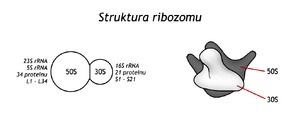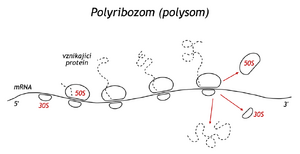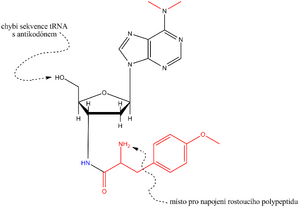Translation in prokaryotes
Structure of ribosomes[edit | edit source]
The bacterial ribosome was the first cellular organelle described in detail at the molecular level. The ribosome of E. coli is a ribonucleoprotein particle (70S, Mr = 2,5 milionu), consisting of one smaller (30S) and one larger (50S) subunit . The smaller subunit contains one molecule of ribosomal RNA (16S rRNA) and 21 protein molecules, designated S1, S2,...S21. In bacteria, the larger subunit (50S) consists of two rRNAs (23S and 5S) and 34 proteins, hence L1, L2,...L34). Most proteins are represented by one molecule in a particle. The components of the ribosomal subunits are arranged so that the organelle can perform binding, catalytic and regulatory functions, and to change conformation and move the mRNA molecule . The larger subunit is shaped like an armchair, the smaller one is oval.
Initiation of translation[edit | edit source]
The synthesis of the peptide chain is initiated in bacteria by the formation of an initiation complex, sconsisting of the 30S subunit, mRNA and the initiator aa–tRNA, which in bacteria is N–formylmethionyl–tRNA (fMet–tRNAiMet). This aa–tRNA binds to mRNA with an initiation codon AUG (sometimes also GUG, read as a signal for Met). A stretch before the initiation codon (Shine–Dalgarn sequence), was discovered on the mRNA, which is complementary to the 3'-end of the 16S rRNA. The association of the mRNA with the 16S rRNA contributes to the correct localization of the mRNA on the ribosome.
The initiation complex is formed by first binding the protein initiation factors IF1, IF2 and IF3 to the 30S subunit. Binding of GTP to IF2 allows binding of this complex to mRNA and initiation Met–tRNA. The initiation complex 30S.IF3.mRNA.IF1.IF2.fMet–tRNA.GTP is formed. The 50S ribosomal subunit then binds to it. At the same time, the factors IF1, IF2, IF3 are released and GTP is hydrolyzed to GDP and phosphate.
Both fMet–tRNAandMet occupy the so-called peptidyl site P on the ribosom. Another, amino acid site A, is intended to bind another aa–tRNA, corresponding to the codon following AUG.
Methionine is formylated by transformylase with the participation of N10–formyltetrahydrofolic acid and only after binding of the amino acid to the initiation tRNAf Met–tRNAm, including methionine inside the peptide chain, is also recognized by the AUG codon, during translation it binds to the amino acid site of the ribosome and is not formylated. The described modification of the initiation Met–tRNA is not known in eukaryotes.
Peptide Elongation[edit | edit source]
Elongation of the synthesized peptide takes place in three steps:
1st phase: Binding of another aa-tRNA to the aminoacyl site of the ribosome. This aminoacyl–tRNA is selected by the codon located at this site. It is transported to the ribosome in a complex with the GTP-binding protein elongation factor EF–Tu. Upon transfer of aa–tRNA, GTP is hydrolyzed and EF–Tu is released from the ribosome. The elongation factor EF–Ts attaches to EF–Tu.GDP and changes the conformation of the complex enough to release GDP. Regenerated EF–Tu can enter the next cycle after binding with new GTP. EF–Tu does not respond to both s f–Met–tRNAandMet. Therefore, this aa–tRNA does not bind to the aminoacyl site. However, EF-Tu binds Met-tRNA and thus ensures the inclusion of methionine inside the chain.
During the hydrolysis of GTP and the release of EF–Tu–GDP from the ribosome, the conformation of the factor changes in the vicinity of the currently bound aa–tRNA so much that only the aa–tRNA firmly and precisely bound to the anticodon and the aminoacyl site are not released. If the wrong aa–tRNA with weaker bonds is mistakenly incorporated, translation is released again at this stage. The EF–Tu factor indicates the speed (step) of the entire translation.
The EF–Tu protein belongs to a large and phylogenetically old family of G proteins, which, among other things, are part of the hormonal regulation mechanism.
2nd phase: Peptide bond formation (transpeptidation). Peptide bond formation is catalyzed by peptidyl transferase , which is part of the 50S subunit. Basically, it is a nucleophilic attack of the nitrogen group 2–NH 2 of the attached amino acid group (aa–tRNA at site A) on the carboxyl carbon of f–Met–tRNAiMet or peptidyl–tRNA located at site P. A peptide bond is formed between the amino acids involved bond and at the same time the ester bond between the amino acid and the tRNA at the P site is cleaved. At the A site, a peptidyl-tRNA is thus formed. In other words, the peptidyl is transferred from the preceding tRNA to the NH2 group of the following aa–tRNA, thereby extending the chain by one amino acid. It follows that the peptide chain grows from the N-terminus to the C-terminus.
Phase 3: Translocation Translocation is a process in which the free tRNA is released from the peptidyl site and the mRNA moves by 3 nucleotides (one codon), so that the peptidyl-tRNA moves from site A to site P. Elongation factor EF is required for the shift –G with bound GTP, which belongs to the mentioned G proteins as EF–Tu. GTP hydrolysis releases EF–G from the ribosome. Another aa–tRNA can bind to the vacant A site and the cycle repeats. In this way, the mRNA moves along the ribosome, from which the growing polypeptide chain unfolds at the same time.
Termination of translation[edit | edit source]
During polypeptide synthesis, the ribosome moves to the terminator , i.e. the codon, signaling the end of translation. It is a UAG, UAA or UGA codon. None of them encodes the inclusion of any amino acid in the peptide, these codons are recognized by one of the protein releasing termination factors (releasing factors). Factor RF1 recognizes UAA and UAG, RF2 recognizes UGA and UAA. After the factor binds to the ribosome, the peptidyl-tRNA moves from the A site to the P site. The specificity of the peptidyl transferase changes so that it switches the peptidyl to a water molecule instead of 2–NH2 another aa–tRNA. In other words, the finished peptide is hydrolytically released from the last tRNA. tRNA and mRNA are released and the ribosome breaks up into 50S and 30S subunits. The initiation factor IF3 immediately binds to 30S and thus prevents reassociation of the ribosome, which would be non-functional because it does not contain mRNA. Individual components can participate in the creation of a new initiation complex and start a new cycle. Several ribosomes are simultaneously bound to a single mRNA, which move along the mRNA chain at a certain distance, and on each of them the synthesis of one peptide takes place. The entire structure is called a polysome. In this way, the mRNA is used very efficiently.
Inhibitors of bacterial translation[edit | edit source]
A number of antibiotics used in medical practice and for research purposes inhibit some phase of translation.
Streptomycin prevents the binding of both fMet–tRNAandMet on the 30S–subunit of the ribosome and prevents the initiation of translation. In addition, misreading of the genetic code is the cause.
Tetracycline also binds to the 30S subunit and inhibits the attachment of aa–tRNA at site A. The commonly used chloramphenicol inhibits bacterial peptidyl transferase (toxic cycloheximide acts in an analogous manner on eukaryotic translation). Erythromycin stops translation by binding to the 50S subunit. These antibiotics are used to treat bacterial infections, while puromycin is successfully used for scientific purposes, to study the mechanism of proteosynthesis. Its structure mimics the 3'-end of tyrosinyl-tRNA. Methyltyrosinyl in puromycin is bound by a strong amide bond, not an ester bond, and the molecule has no anticodon. At site A, the growing peptide is transferred to puromycin and the resulting peptidyl-puromycin is released from the ribosome. Peptide synthesis is thus prematurely interrupted.
Links[edit | edit source]
[edit | edit source]
Resources[edit | edit source]
- ŠTÍPEK, Stanislav. Brief biochemistry : Storage and expression of genetic information. 1. edition. Medprint, 1998. 92 pp. pp. 45–49. ISBN 80-902036-2-0.
Categorie:Biochemistry Categorie:Molecular Biology Categorie:Genetics







